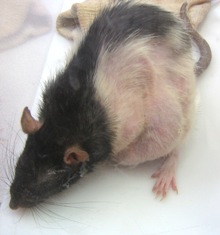Tumors, Abscesses, Cysts in Rats
Rats are prone to a variety of lumps and growths beneath their skin. Many times these are abscesses or infections that accumulate pus beneath the skin. In older rats, typically 18 months or older, cancerous tumors are more common as the cause of bumps. The tumors may be benign ones such as adenomas or lipomas, or they may be more serious ones classified as adenocarcinomas. Most tumors are readily removed at a small size and many of them do not return if the surgery was able to completely remove the growth. If you see a bump on your rat, don't wait until it gets big to get it checked. The sooner we see your pet, the better the chances are that we can help!
Mammary Tumors
Mammary tumors are very common in unspayed female rats over 18 months old and in rats that were more than 4 to 6 months old at the time of spay. About 10% of male rats can develop mammary tumors. Depending on the genetic strain of rat, around 90% of mammary tumors are benign which means they do not spread. Tumor removal does not guarantee that another tumor will not develop, but tumor removal in combination with a spay tends to significantly reduce the risk of new tumors developing. A rat that has a benign tumor and tumor removal and spay will typically live a full life. Many younger rats have lived up to an additional 2 years following surgery.
Surgery is not the right choice for some rats. Many rats do well without surgery and have a normal quality of life until the tumor is so large it interferes with movement or it develops scabs or ulcers, at which time humane euthanasia should be considered.
If you decide to get a female rat as a pet in the future, it is very important to have it spayed when it is around 3 to 4 months of age. This eliminates the chance of reproductive disease. This also greatly reduces the chance of a rat developing a mammary tumor as she ages. It is one of the most important things you can do to extend her life.

Rat Pituitary Tumors
A pituitary tumor is an abnormal growth of the pituitary gland, which sits just under the brain. It is one of the more common tumor types that rats are at risk for as they age. A majority of pituitary tumors in rats are pituitary adenomas. These are benign, meaning the cells do not spread to other parts of the body. However, because of the location of the pituitary gland, excessive growth can place pressure on the brain and brainstem. This can lead to neurological signs that worsen as the tumor grows.
The most common sign of a pituitary tumor in a rat is difficulty performing normal movements. Owners may notice that their rat is having trouble climbing, sitting at the bottom of their cage, and may appear off-balance while walking. A rat may also have difficulty using their front paws for grooming and grasping food. In lighter colored rats, owners may notice pink or red staining around the face and head from porphyrin that is not completely cleaned away. Signs can progress to a rat being unable to eat or drink on their own. A CT scan may be used to confirm a diagnosis of pituitary tumor, but unfortunately, there is no way to remove a pituitary tumor in a rat safely.
There are two medications (cabergoline and bromocriptine) that can be used to slow tumor growth and delay the progression of symptoms. These medications work by inhibiting tumor cells from producing hormones. The efficacy of these medications is variable; some rats respond very well, and some not at all. Other medications that can be used to ease swelling and inflammation are steroids. Because long-term use of steroids can suppress the immune system, they may be prescribed alongside a long-term course of antibiotics depending on the case.
The most important part of caring for a rat with a pituitary tumor is supportive care and monitoring quality of life. Owners should keep track of how well their rat is able to eat, drink, walk, and groom on their own. Additionally, keeping a log of an individual rat’s favorite things to do and how well they can still do those things can help to monitor quality of life.
Abscesses and Cysts
Abscesses may be simple to treat after they have been surgically drained. A course of antibiotics and anti-inflammatory medication may be all that is needed after a minor surgical procedure. Some abscesses are resistant to treatment and may require multiple surgeries and more intensive medical therapy.
Cysts are accumulations of material in the glands of the skin. Some cysts will rupture and ooze gray to white material. Other cysts will need to be surgically removed.



